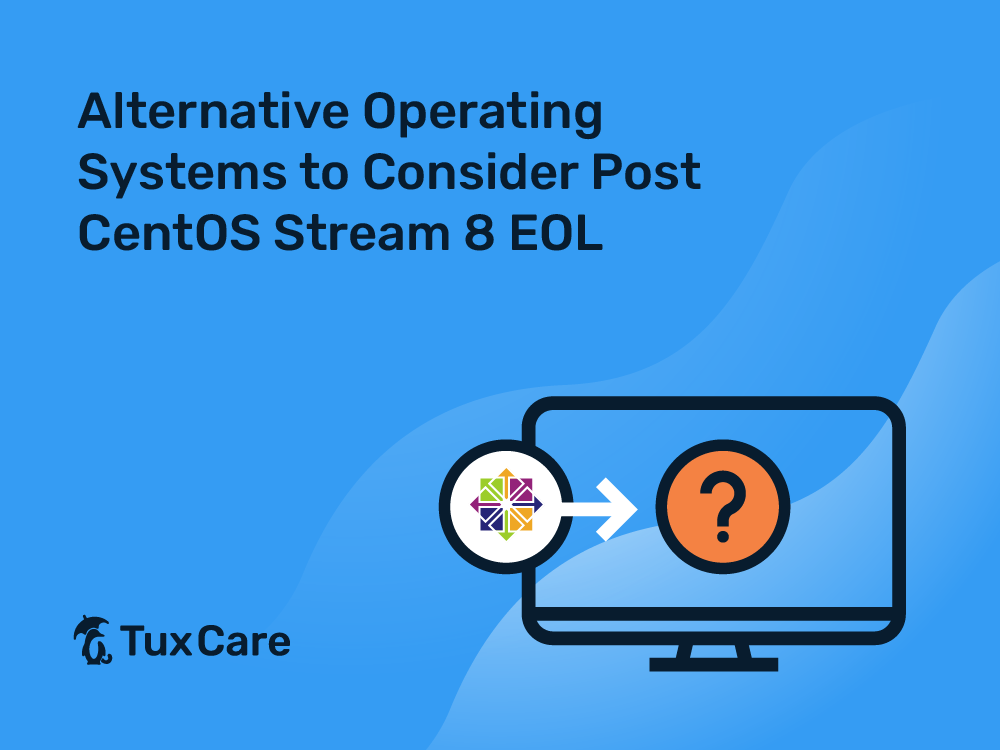Alternative Operating Systems to Consider Post CentOS Stream 8 EOL
- The nearing CentOS Stream 8 EOL on May 31st, 2024, left many users and organizations scrambling for alternatives
- Users can either migrate to alternative Linux distributions or choose Extended Lifecycle Support services because upgrading to CentOS Stream 9 is not possible
- TuxCare extends the life of CentOS Stream 8 by providing updates for Critical and High-risk vulnerabilities years beyond the EOL date
After the end of its predecessor CentOS Linux 8, CentOS Stream 8 emerged as one of the go-to alternatives that organizations migrated to. However, it is criticized for becoming the upstream development branch for RHEL, questioning the stability and reliability of enterprise servers and mission-critical systems. But now, CentOS Stream 8 has also received the same fate, leaving many users and organizations to search for new solutions.
In this article, we will explore alternative Linux distributions and operating systems that users can consider migrating to after the CentOS Stream 8 EOL.
Understanding the CentOS Stream 8 EOL
The End of Life (EOL) for CentOS Stream 8 means that the official support and maintenance for this specific version have come to an end. When an operating system reaches its EOL, the developers and maintainers stop providing updates, security patches, or bug fixes to that release. This lack of ongoing support can pose serious risks, particularly in terms of potential security flaws that may evolve over time.
CentOS Stream 8 is scheduled to reach the end of life on May 31, 2024. With no security updates or patches, the systems will be highly vulnerable to new security threats and exploits discovered after the EOL date. This may be devastating for organizations with specific security and compliance requirements that necessitate ongoing protection.
Alternative Linux Distributions
AlmaLinux OS
Pros
Direct CentOS replacement: AlmaLinux OS offers a smooth transition for CentOS Stream users as it is application binary compatible with RHEL.
Long-term support: AlmaLinux commits to long-term support, ensuring stability and security updates for the foreseeable future.
Community-driven: AlmaLinux is a community-owned and governed enterprise Linux distribution, freely available as open source, making it a reliable drop-in replacement after CentOS Stream 8 EOL.
Cons
Less established: Although AlmaLinux is gaining popularity, it is still considered relatively new compared to CentOS.
Rocky Linux
Pros
RHEL-like experience: Created by the co-founder of CentOS, Rocky Linux aims to be a true upstream-compatible alternative, providing a familiar RHEL-like experience.
Strong community support: With robust community support, Rocky Linux has created a collaborative environment where users can exchange knowledge and experiences.
Backing from sponsors: Supported by the community and various sponsors, Rocky Linux is well-positioned to become one of the best CentOS Stream 8 EOL alternatives.
Cons
Early stage: While promising, Rocky Linux is still in its early stages, and users may encounter some growing pains or a lack of certain features.
Oracle Linux
Pros
RHEL compatibility: Oracle Linux is based on the same upstream sources as RHEL, making it highly compatible with RHEL applications.
Unbreakable Enterprise Kernel: Oracle Linux offers the Unbreakable Enterprise Kernel, providing enhanced performance, scalability, and security features.
Cons
Proprietary components: Some users may be hesitant about Oracle Linux due to its inclusion of certain proprietary components, potentially impacting the open-source ethos of their infrastructure.
Ubuntu Server
Pros
Ease of use: Ubuntu is known for its user-friendly interface, making it accessible to users with varying levels of Linux experience.
Large community support: Ubuntu has a massive and active community, ensuring ample resources for troubleshooting and support.
Cons
Package management: The package format (deb) is different from CentOS/RHEL (rpm), which may require additional work.
Frequent releases: While some appreciate the regular updates, others may find Ubuntu’s frequent release cycle less appealing in a production environment where stability is paramount.
Red Hat Enterprise Linux (RHEL)
Pros
Direct successor to CentOS Stream 8, long-term support, enterprise-grade stability and security.
Cons
Paid subscription, a steeper learning curve compared to CentOS.
Not Ready To Migrate Yet?
Switching to a new Linux distribution often involves costs related to reconfiguration, testing, and potential service disruptions. It requires comprehensive planning and testing of the chosen alternatives beforehand to ensure a smooth transition.
However, migrating is not only a viable solution to the security risks of CentOS Stream 8 EOL. For enterprises looking to maintain the ongoing security of their CentOS Stream 8 installations without incurring the expenses of a migration, TuxCare’s Extended Lifecycle Support for CentOS Stream 8 is a cost-effective option.
TuxCare extends the lifecycle of EOL distributions for years after the EOL date, offering ongoing security patches and ensuring that vulnerabilities are addressed even after the official support period ends. This also gives organizations additional time to strategize migration without rushing into a decision.
Final Thoughts
As CentOS Stream 8 EOL approaches, users and organizations have several options to mitigate the associated security risks. Whether migrating to a new distribution or opting for extending support, your organization’s decision ultimately depends on the existing infrastructure and its specific needs and preferences.
Speak to a TuxCare Linux security expert to get started with extended support for your CentOS Stream 8 deployments.



 Documentation
Documentation Login
Login




